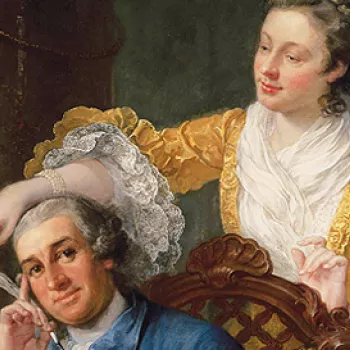Moses and the Miracle of the Rock c. 1716-20
Oil on canvas | 99.3 x 134.9 cm (support, canvas/panel/stretcher external) | RCIN 402899
-
This work is a collaboration of Sebastiano and Marco Ricci. Sebastiano Ricci trained with Federico Cervelli (c.1625–1700) in Venice; he worked throughout Italy before making several visits to Germany, where he was recorded in 1702, and England, where he spent the years 1712–6. In 1715 he was given the prestigious commission by George I to decorate the apse of the chapel of Chelsea Hospital with a fresco of the Resurrection of Christ. Sebastiano first came to England apparently at the instigation of his nephew and pupil Marco. Uncle and nephew often collaborated, Marco providing the architectural or landscape backgrounds for Sebastiano’s large canvases and Sebastiano providing figures for Marco’s small landscapes.
This work is probably an oil sketch for a large painting executed in 1718–20 for the church of Santi Cosma e Damiano in Venice and now in the Accademia. Exodus (17: 1–7 and 20: 1–13) tells how in the desert the Israelites were saved by Moses striking a rock and causing it to gush fresh water. The group high on the rock to the right includes Aaron sacrificing to Jehovah, while the white-cloaked man in the right middleground, accompanied by a soldier and addressing his people, seems to be Moses. This figure becomes more prominent in the finished painting. The emphasis given to a rugged landscape peopled by a varied crowd derives from Poussin’s treatment of the Book of Exodus, in particular his Israelites gathering Manna (Louvre), a painting which was regarded as the model for judicious and inventive multi-figure narrative. This openness to French as well as native influences is typical of Venetian painting in the early eighteenth century. Sebastiano Ricci shows that he too can distinguish between different ages (an elderly woman bottom right contrasted with a mother and children bottom left); different actions (scooping water with hands or bowls, carrying vessels of various sizes) and different temperaments (the greedy and the sharing). The woman in blue and white, crouching and turning upwards, appears to be offering a bowl of water to the soldier, so that he may feed two children who clutch at his side. A preparatory sketch for the same group (RCIN 907014) shows the soldier filling her bowl from a larger vessel. In this way Sebastiano Ricci subtly alters the meaning, making this central woman, like the mother to the lower left and the man to the lower right, into an emblem of Charity.
Marco Ricci executed the landscape and has similarly contrasted the blasted trunk to the right with the flourishing trees to the left, which seem instantly to have benefited from the stream winding around them. The application of the paint has a twisting capricious brilliance which is typical of both Riccis’ work, especially in a sketch, and of Venetian art in general.
Text adapted from The First Georgians: Art and Monarchy, 1714-1760, London 2014Provenance
Acquired in 1762 by George III from Joseph Smith, British Consul in Venice (Italian List no 37 as Sebastiano andf Marco Ricci); recorded in the Queen's Drawing Room at Kew in 1805 (no 12)
-
Creator(s)
Acquirer(s)
-
Medium and techniques
Oil on canvas
Measurements
99.3 x 134.9 cm (support, canvas/panel/stretcher external)
114.2 x 150.1 x 6.5 cm (frame, external)









